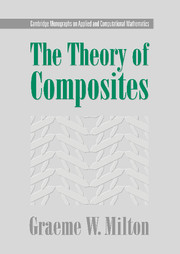Book contents
- Frontmatter
- Contents
- List of figures
- Preface
- 1 Introduction
- 2 Some equations of interest and numerical approaches to solving them
- 3 Duality transformations in two-dimensional media
- 4 Translations and equivalent media
- 5 Some microstructure-independent exact relations
- 6 Exact relations for coupled equations
- 7 Assemblages of spheres, ellipsoids, and other neutral inclusions
- 8 Tricks for generating other exactly solvable microgeometries
- 9 Laminate materials
- 10 Approximations and asymptotic formulas
- 11 Wave propagation in the quasistatic limit
- 12 Reformulating the problem of finding effective tensors
- 13 Variational principles and inequalities
- 14 Series expansions for the fields and effective tensors
- 15 Correlation functions and how they enter series expansions†
- 16 Other perturbation solutions
- 17 The general theory of exact relations and links between effective tensors
- 18 Analytic properties
- 19 Y-tensors
- 20 Y-tensors and effective tensors in electrical circuits†
- 21 Bounds on the properties of composites
- 22 Classical variational principle bounds
- 23 Bounds from the Hashin-Shtrikman variational inequalities
- 24 Bounds using the compensated compactness or translation method
- 25 Choosing the translations and finding microgeometries that attain the bounds†
- 26 Bounds incorporating three-point correlation functions†
- 27 Bounds using the analytic method
- 28 Fractional linear transformations as a tool for generating bounds†
- 29 The field equation recursion method†
- 30 Properties of the G-closure and extremal families of composites
- 31 The bounding of effective moduli as a quasiconvexification problem
- Author index
- Subject index
10 - Approximations and asymptotic formulas
- Frontmatter
- Contents
- List of figures
- Preface
- 1 Introduction
- 2 Some equations of interest and numerical approaches to solving them
- 3 Duality transformations in two-dimensional media
- 4 Translations and equivalent media
- 5 Some microstructure-independent exact relations
- 6 Exact relations for coupled equations
- 7 Assemblages of spheres, ellipsoids, and other neutral inclusions
- 8 Tricks for generating other exactly solvable microgeometries
- 9 Laminate materials
- 10 Approximations and asymptotic formulas
- 11 Wave propagation in the quasistatic limit
- 12 Reformulating the problem of finding effective tensors
- 13 Variational principles and inequalities
- 14 Series expansions for the fields and effective tensors
- 15 Correlation functions and how they enter series expansions†
- 16 Other perturbation solutions
- 17 The general theory of exact relations and links between effective tensors
- 18 Analytic properties
- 19 Y-tensors
- 20 Y-tensors and effective tensors in electrical circuits†
- 21 Bounds on the properties of composites
- 22 Classical variational principle bounds
- 23 Bounds from the Hashin-Shtrikman variational inequalities
- 24 Bounds using the compensated compactness or translation method
- 25 Choosing the translations and finding microgeometries that attain the bounds†
- 26 Bounds incorporating three-point correlation functions†
- 27 Bounds using the analytic method
- 28 Fractional linear transformations as a tool for generating bounds†
- 29 The field equation recursion method†
- 30 Properties of the G-closure and extremal families of composites
- 31 The bounding of effective moduli as a quasiconvexification problem
- Author index
- Subject index
Summary
Countless approximations for estimating effective moduli have been introduced; some are semi-empirical, some are based on ad-hoc assumptions, and some have a reasonable theoretical basis. Here we will only review those well-known approximations that have a reasonable theoretical foundation, and which have withstood the test of time; see also the reviews of Van Beek (1967), Landauer (1978), Willis (1981), Markov (2000), and Buryachenko (2001). In addition, we discuss various asymptotic formulas that are applicable in high-contrast media.
Polarizability of a dielectric inclusion
Many approximations for the effective moduli of composites are based on the solution for dilute suspensions. For simplicity, let us suppose that we are interested in approximating the effective dielectric constant and require the solution for a dilute suspension of inclusions embedded in an isotropic matrix of dielectric constant ε0I. Since the grains are well-separated from each other, the field acting on each inclusion will be approximately uniform. To a good approximation we can solve for the field in the neighborhood of any such inclusion by treating it as if it was embedded in an infinite homogeneous medium of dielectric constant ε0 and subject to a uniform applied field at infinity. The analysis of this problem is the focus of the this section.
Consider an isolated, possibly inhomogeneous, inclusion that is embedded in an isotropic matrix of dielectric constant ε0 and subject to a uniform applied electric field a at infinity.
- Type
- Chapter
- Information
- The Theory of Composites , pp. 185 - 220Publisher: Cambridge University PressPrint publication year: 2002
- 1
- Cited by



